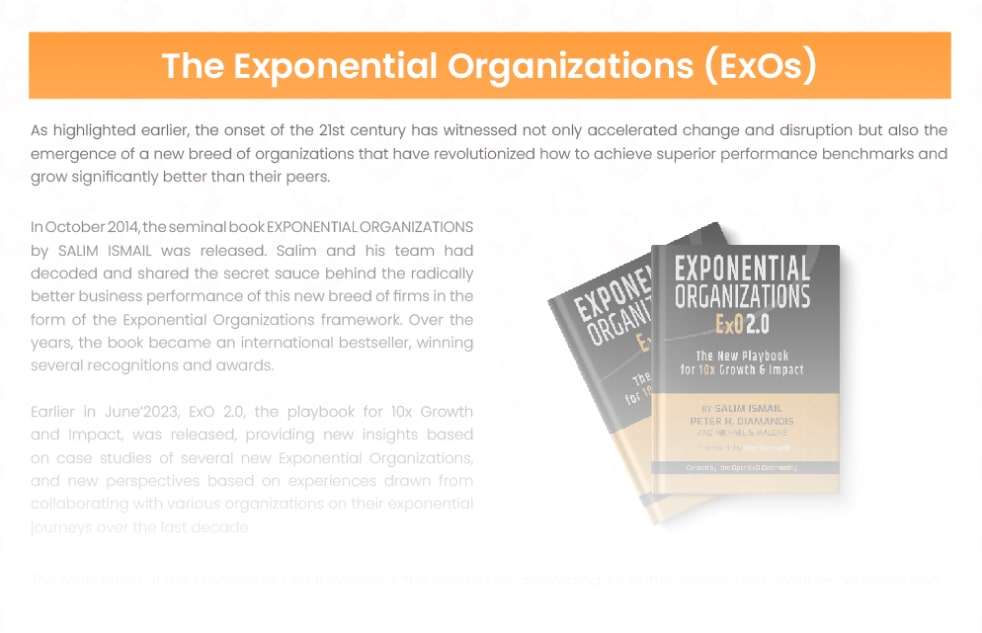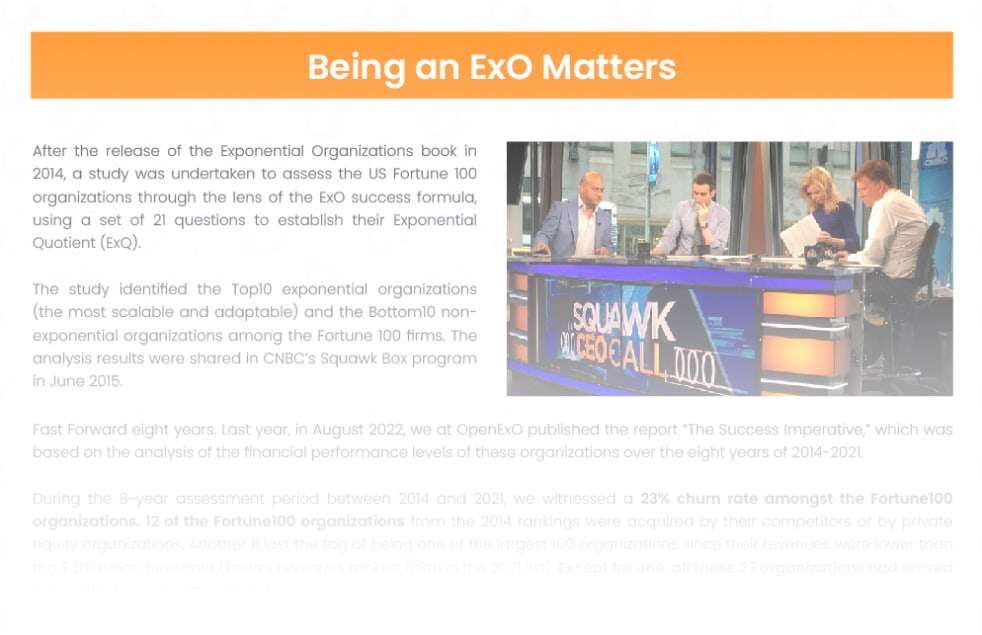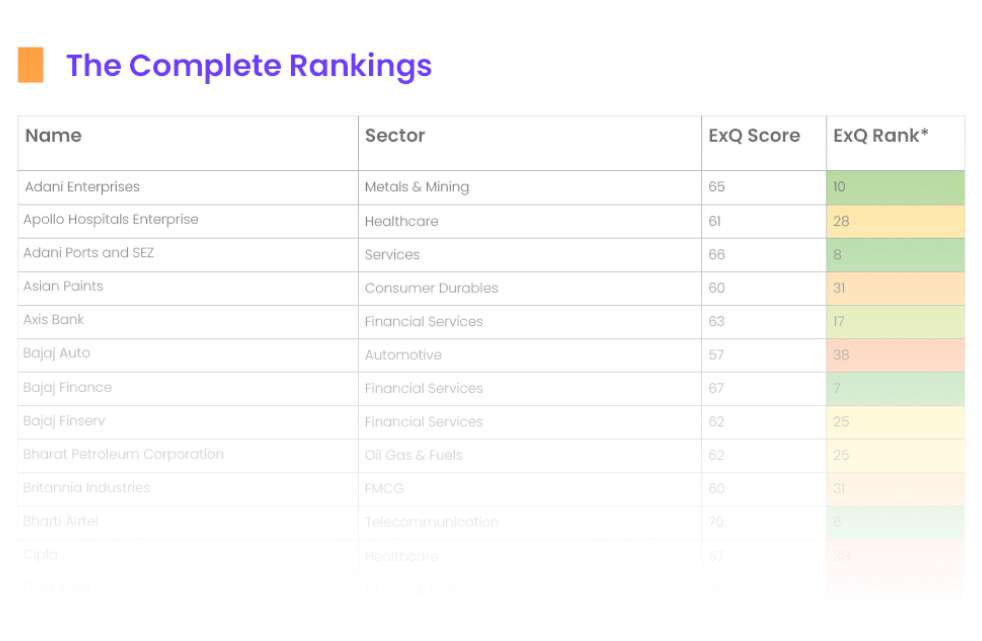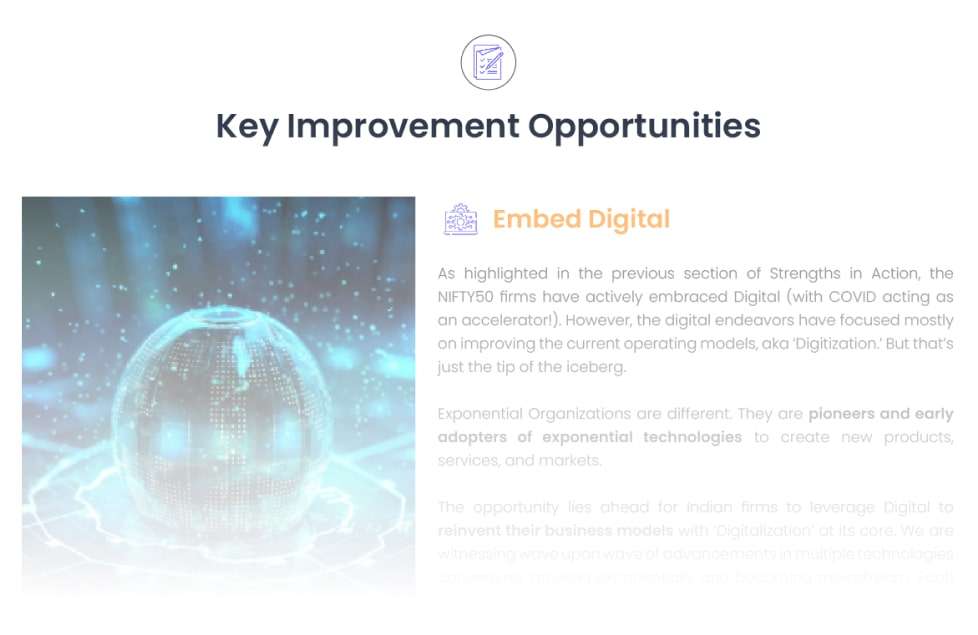Description Text.
Click the button below if you would like to see this feature in the future.
Building Competitive, Sustainable Exponential Organizations.
Insights and Recommendations along with Future Readiness Assessment of NIFTY50 Organizations

Authored by Chander Nagpal and Salim Ismail
Executive Summary
An Era of Disruption and Abundance
The Exponential Organizations (ExOs)
Why Being an ExO Matters
Exponential Quotient Assessment of the NIFTY50
Key Strengths in Action
Key Improvement Opportunities
The Road Ahead for a REIMAGINED INDIA


India is the fifth-largest global economy with a GDP of $4 trillion and is estimated to grow at an annualized 6.4% and double in size by 2030, overtaking Japan and Germany.
India is home to well-known corporate names like Tatas, new-era technology firms such as Infosys, and global multinationals such as Unilever. The crème-de-la-crème of Indian organizations is represented through the NIFTY50 index, its constituents coming from 14 critical sectors of the economy. These NIFTY50 firms generated combined Revenues of $780 billion in the financial year 2022-23 and had a Market Capitalization of $1.84 trillion as of September’23.
In the context of the growing significant and defining role being played by Indian businesses globally, we at OpenExO set out to ascertain the future readiness (scalability and adaptability, agility, and resilience) of Indian firms, especially the larger incumbents. We assessed the NIFTY50 constituents (as of July’23) as representatives of the Indian Inc.
And we assessed them through the lenses of the 11 attributes of MTP + S.C.A.L.E. + I.D.E.A.S. leveraged by the new breed of highly successful firms called the Exponential Organizations (ExOs) – to stay ahead of the curve, outperform their peers, and deliver holistic positive impact.
And, being Exponential matters. We had established this through an in-depth analysis of the financial performance of Fortune100 firms over the period of 2014-2021. The top10 Exponential Organizations amongst the Fortune100 had outperformed their non-exponential bottom10 peers by delivering a staggering 40x higher shareholder returns, 6.8x higher profitability, 2.6x better revenue growth, and 11.7x better asset utilization.
Through this inaugural publication, we share with the Indian and global business leaders and policymakers our analysis of the ‘Exponential Quotient’ (ExQ) rankings for the NIFTY50 constituents and the four key strengths and four key improvement opportunities displayed by the NIFTY50 firms at an overall level.
Building upon the current best practices and addressing the highlighted improvement opportunities would enable Indian organizations to Thrive in the current era of disruption yet abundance and, more significantly, create a Reimagined, Competitive, and Sustainable India.
India is the fifth-largest global economy with a GDP of $3.5 trillion and is estimated to grow at an annualized 6.4% and double in size by 2030, overtaking Japan and Germany.
India is home to well-known corporate names like Tatas, new-era technology firms such as Infosys, and global multinationals such as Unilever. The crème-de-la-crème of Indian organizations is represented through the NIFTY50 index, its constituents coming from 14 critical sectors of the economy. These NIFTY50 firms generated combined Revenues of $780 billion in the financial year 2022-23 and had a Market Capitalization of $1.84 trillion as of September’23.

In the context of the growing significant and defining role being played by Indian businesses globally, we at OpenExO set out to ascertain the future readiness (scalability and adaptability, agility, and resilience) of Indian firms, especially the larger incumbents. We assessed the NIFTY50 constituents (as of July’23) as representatives of the Indian Inc.
And we assessed them through the lenses of the 11 attributes of MTP + S.C.A.L.E. + I.D.E.A.S. leveraged by the new breed of highly successful firms called the Exponential Organizations (ExOs) – to stay ahead of the curve, outperform their peers, and deliver holistic positive impact.
Through this inaugural publication, we share with the Indian and global business leaders and policymakers our analysis of the ‘Exponential Quotient’ (ExQ) rankings for the NIFTY50 constituents and the four key strengths and four key improvement opportunities displayed by the NIFTY50 firms at an overall level.
Building upon the current best practices and addressing the highlighted improvement opportunities would enable Indian organizations to Thrive in the current era of disruption yet abundance and, more significantly, create a Reimagined, Competitive, and Sustainable India.
We find ourselves at a critical juncture in human history when our world is evolving at an increasingly accelerated pace, characterized by what’s often called VUCA (Volatility, Uncertainty, Complexity, and Ambiguity). We are seeing radical shifts in demographics, consumer behaviors, global and regional geopolitics, and societal fabrics, and perhaps most significantly, we are witnessing wave upon wave of technological advancements converging and growing exponentially.

Ronald H. Coase won the Nobel Prize in 1991 for his discovery and clarification of the significance of transaction costs and property rights for the institutional structure and functioning of the economy. His rationale was that, for big companies, internal transaction costs were lower than getting things done on the outside, thus creating economies of scale. This became known as Coase’s Law.
However, over the last two decades, the enormous power of technology has broken Coase’s Law. Between mobile phones, the internet, and AI, the lines between a large organization and the outside world have blurred and become fragmented. As a result, we have been seeing large operating companies giving way to platforms, and platforms are transforming into ecosystems. What’s most incredible about this ongoing transformation is its sheer speed.
A hundred years ago, the average lifespan of an S&P 500 company was 67 years. Today, it’s about 15 years. And it will get even shorter. Over half of the companies that made up the Fortune 500 in 2000 have vanished. Giants like Blockbuster, Kodak, Nokia, Sears, Yahoo, Xerox, and Toys “R” Us have fallen by the wayside via bankruptcy, acquisition, shutdown, or becoming a far more petite version of their original size.
The word “exponential” signifies not just a theory but also a warning: the business world is moving so quickly and purposefully that if you’re not already changing your business model and thinking differently, you will be fatally left behind.
It is a place where neither age, size, reputation, or even current sales guarantees that your organization will be around tomorrow. On the other hand, it also offers abundant opportunities where, if you can build an organization that is sufficiently scalable, fast-moving, and smart, you may enjoy success to an- imaginable degree. And all this with far fewer resources and in far less time than the businesses of previous decades.
Understand the ExO Model
Be Mentored live by International Coaches
Identify Your 10x Growth Potential
Harness the Power of the ExO Canvas and other tools
Access a Dedicated Q&A Space





